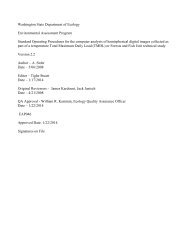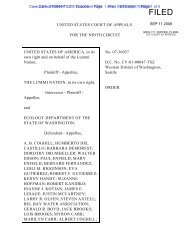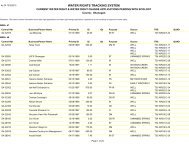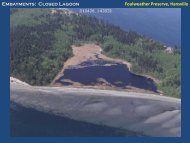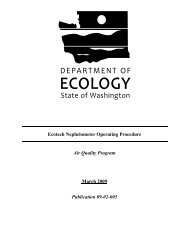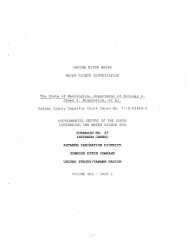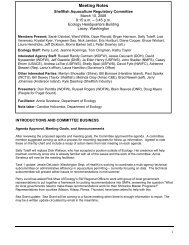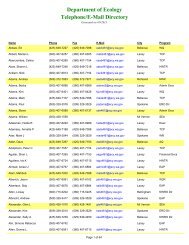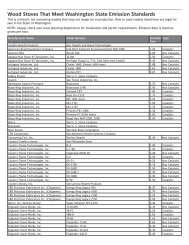General Permit for Biosolids Management - Washington State ...
General Permit for Biosolids Management - Washington State ...
General Permit for Biosolids Management - Washington State ...
You also want an ePaper? Increase the reach of your titles
YUMPU automatically turns print PDFs into web optimized ePapers that Google loves.
<strong>General</strong> <strong>Permit</strong> <strong>for</strong> <strong>Biosolids</strong> <strong>Management</strong> Page 34<br />
APPENDIX 3 - SITE SPECIFIC LAND APPLICATION PLAN<br />
CONTENT<br />
1) Whether or not it is known or can be determined that biosolids containing pollutants in excess of the values<br />
WAC 173-308-160 Table 3 have ever been applied to the site, and if so:<br />
The date(s) when the biosolids were applied (if known).<br />
The amount of biosolids applied (if known).<br />
The concentrations of the pollutants in the biosolids (if known).<br />
The area(s) of the site to which the biosolids were applied (if known).<br />
2) A discussion of the types of crops grown or expected to be grown, their intended end use (<strong>for</strong> example,<br />
pasture grass <strong>for</strong> a feed crop, corn as a food crop), and the current distribution of crops on the site.<br />
3) An explanation of how agronomic rates will be determined during the life of the site, along with any currently<br />
available calculations. Whenever agronomic rates or the method used to determine agronomic rates change,<br />
an update of the agronomic rate calculations must be filed with Ecology.<br />
4) Method(s) of application.<br />
5) Seasonal and daily timing of biosolids applications.<br />
6) Provisions <strong>for</strong> conducting any soils, surface waters, or ground water sampling and any available data collected<br />
from the site within the last 2 years.<br />
7) The name of the county and water resource inventory area where biosolids will be applied.<br />
8) A description of how biosolids will be stored at the site that also addresses related off-site storage.<br />
9) Map(s) <strong>for</strong> the site(s) must be submitted. Maps must be of an appropriate scale to show the detail necessary<br />
<strong>for</strong> evaluation of the proposed application areas, and so that a person may reasonably be able to locate the<br />
sites and any application units within a site (<strong>for</strong> example, 1:7,920 [8 inches to the mile] <strong>for</strong> detailed<br />
in<strong>for</strong>mation with an overview map at 1:63,360 [1 inch to the mile]). Minimally, maps must provide the<br />
following in<strong>for</strong>mation:<br />
A legend.<br />
The location and means of access.<br />
Specific areas of the site where biosolids may be applied. If there is more than one site or more than one<br />
application unit within a site, a site or unit ID number should be included.<br />
The number of acres in the site or in any distinct application unit within a site.<br />
Location and extent of any wetlands on the site.<br />
A topographic relief of the application site and surrounding area.<br />
Adjacent properties and uses, and their zoning classification.<br />
Any seasonal surface water bodies located on the site.<br />
Any perennial surface water bodies located on or within 1/4 mile (402 meters) of the site.<br />
The location of any wells located on or within 1/4 mile (402 meters) of the site that are listed in public<br />
records or otherwise known to the applicant, whether <strong>for</strong> domestic, irrigation, or other purposes.<br />
Buffer zones to features such as surface waters, wells, property boundaries, and roadways and the width<br />
of the buffer zones.<br />
The presence and extent of any threatened or endangered species or related critical habitat.<br />
The location of any critical areas on site, as required to be identified under Chapter 36.70A RCW in the<br />
county's growth management plan.<br />
The location and size of any areas that will be used to store biosolids.<br />
10) If the seasonal ground water is 3 feet (0.91 meters) or less below the surface, a management plan describing<br />
how you will protect ground water. For example, you may propose to limit applications to the time of year<br />
when ground water has receded to more than 3 feet (0.91 meters) below the surface.<br />
11) A description of how access to the site will be restricted (<strong>for</strong> example, signs posted around the site or other<br />
approved method of access restriction).<br />
12) A copy of the landowner agreement required under WAC 173-308-120(6).<br />
13) Any additional in<strong>for</strong>mation requested by Ecology that is needed to evaluate the appropriateness of the site <strong>for</strong><br />
biosolids application.



